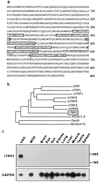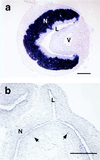TRP2: a candidate transduction channel for mammalian pheromone sensory signaling
- PMID: 10318963
- PMCID: PMC21939
- DOI: 10.1073/pnas.96.10.5791
TRP2: a candidate transduction channel for mammalian pheromone sensory signaling
Abstract
The vomeronasal organ (VNO) of terrestrial vertebrates plays a key role in the detection of pheromones, chemicals released by animals that elicit stereotyped sexual and aggressive behaviors among conspecifics. Sensory transduction in the VNO appears unrelated to that in the vertebrate olfactory and visual systems: the putative pheromone receptors of the VNO are evolutionarily independent from the odorant receptors and, in contrast to vertebrate visual and olfactory transduction, vomeronasal transduction is unlikely to be mediated by cyclic-nucleotide-gated channels. We hypothesized that sensory transduction in the VNO might instead involve an ion channel of the transient receptor potential (TRP) family, members of which mediate cyclic-nucleotide-independent sensory responses in Drosophila melanogaster and Caenorhabditis elegans and play unknown functions in mammals. We have isolated a cDNA (rTRP2) from rat VNO encoding a protein of 885 amino acids that is equally distant from vertebrate and invertebrate TRP channels (10-30% amino acid identity). rTRP2 mRNA is exclusively expressed in VNO neurons, and the protein is highly localized to VNO sensory microvilli, the proposed site of pheromone sensory transduction. The absence of Ca2+ stores in sensory microvilli suggests that, in contrast to a proposed mechanism of activation of mammalian TRP channels, but in accord with analysis of TRP function in Drosophila phototransduction, the gating of TRP2 is independent from the depletion of internal Ca2+ stores. Thus, TRP2 is likely to participate in vomeronasal sensory transduction, which may share additional similarities with light-induced signaling in the Drosophila eye.
Figures




References
Publication types
MeSH terms
Substances
Associated data
- Actions
Grants and funding
LinkOut - more resources
Full Text Sources
Other Literature Sources
Molecular Biology Databases
Miscellaneous

